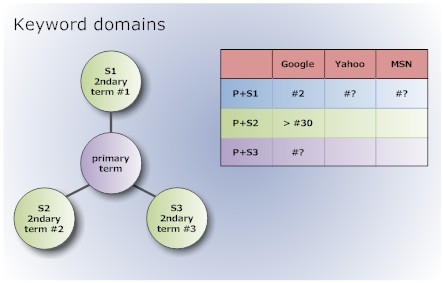Search Engine Journal’s Ahmed Bilal has an article at Marketing niche SEO and how the industry will change in the next two months. It’s part of the scholarship contest, and an excellent read, as well as a launching point for this article, which looks at some organic linkbuilding activities.
Recently, one of my clients that I mostly write for said they’d like to rank #1 for two keyphrases for which they are #2 in Google. (Now who doesn’t want to rank #1, right?) For NDA reasons, I can’t disclose the industry or their domain nor what type of service they perform. However, I can say that earn money offline based on their online efforts, and that they are outranked in Google by a competitor who does have a primary keyword in their domain name.
This is isn’t going to be any easy task, and it’ll possibly take a fair bit of time. I do have some experience in the broader niche that they are part of, but I’ve never done any sub-niche optimization. Part of my suggestion to them is as follows:
- Forget about going from #2 to #1 right now, since the effort to move up one spot in the top 10 is probably exponentially increasing. Number 2 is a respectable position for now, but we’ll have a long-term effort in place.
- Focus on the desired phrase and one more, which they’ve overlooked.
- Focus on one search engine, in this case Google, since most of their traffic is from there, and for the regular reasons.
- Start creating fresh content at least a few times per week, to give other relevant sites something to link to.
Part of the problem is that they are a very small startup business in a small niche that suddenly gained several competitors. Their budget is tiny. They cannot actually afford any SEO services, let alone much additional copywriting. What do you do in such a situation? I’m accepting a minimal monthly stipend in payment, and the rest of the payment will be in the future, in the form of services they offer that I’m interested in, as well as future joint opportunities. I’m thinking long-term here, because this market is going to be huge and the whitepapers I’ll be able to write in 2 years will payoff handsomely. If I succeed in this campaign, we all win: myself, the client, the industry, the customers. So I’m very motivated.
The good news is that even the broader niche is relatively small, so link building is easier than for bigger niches. There are few active websites and blogs, and the bulk of keyword domains are parked. That means the client stands a fighting chance to rank for closely related terms. [Remember: #2 position is nothing to be ashamed about. Nor is anything in the top 10 of the SERPs, as far as I’m concerned.]
Let’s use a point of reference. Each keyphrase starts with the same word, indicated in the diagram below as “P”. The second word differs in each, and is indicated below as S1, S2, or S3. The keyphrase that uses P and S1 concatenated is the one that they rank as #2 for in Google. Here’s an example. P=”dog”. S1=”tag”, S2=”house”, S3=”fur”. So that means they rank well for “dog tag” but not “dog house” nor “dog fur”.

Keeping in mind that I’m working with a limited budget and my own personal time constraints, here is my long-term (1 year) strategy:
- Keyword domains.
Register several keyword domains that are variations of the “P+Sn” compound key phrases mentioned above. I’ve registered a bunch, and some use a desired keyphrase plus a verb such as “get” or “find”. E.g., “getdogtags.net”, “finddoghouses.com”. There are even a couple of compound domain names similar to “finddogtagsandtoys”. These use both the primary keyword, two secondary keywords, and some sort of connecting word such as “find” or “and”, etc. - Mini-sites.
Create 4-6 page mini-sites on some, redirect others (in hopes of getting type in traffic). These will be very similar, but optimized for each keyword domain. - Controlled outbound links.
Link out from each mini-site but only to the client’s primary site and a select few competitors. The motivation is that if the visitor wants to learn more about the topic at hand. - Neutral content.
Note that the sites are being maintained by me, not the client. Even with neutral sites, I can still find ways to give the client link prominence without appearing to do so. Being neutral increases the chances of being linked to from elsewhere, even from competitors of my client. - Updates.
Content will be updated from time to time using relevant industry statistics, suitable diagrams, and short linkbait. (Everyone loves diagrams and lists.) - Additional spider bait.
A mashed up web feed of industry sites and blogs, created in Yahoo Pipes, will be burned in Feedburner. I’ll then use their BuzzBoost feature to create an HTML badge of headlines and excerpts. This content will be embedded on each mini-site, in the navigation bar. This gives each site fresh content daily
I wasn’t able to get all .com domains. Some are .net, .biz, .info, but they are valuable keyword domains nevertheless. Unfortunately, some keyphrases have very low search traffic. There might be some type-in traffic, but I have to create interest in the topics elsewhere, in non-industry mediums – somewhere where readers fit the profile of the people who will be purchasing my client’s services but not necessarily participating. This might be blogs or possibly even print articles in CEO/CIO/CTO magazines.
Another phase of the niche link building strategy is as follows:
- Utilize press releases.
They already use web press releases regularly, so these could be utilized to link to the new domains. - Industry sites.
Sites in the industry run by neutral organizations are eager for relevant content. If we offer up short, neutral, “voice of the industry” articles that link to the new sites, other websites will publish them. Even if there is more than one site publishing these articles (i.e., duplicate content), there will be the benefit of targeted traffic. - Bloggers.
Industry bloggers seem to be willing to either republish press releases or link to relevant information. Building a niche blogger contact list will be helpful in the promotional effort.
The entire strategy, thankfully, is long-term, as the industry in question is still tiny. The success of this client – and their competitors – offline is actually an indicator of the health of the industry. A long-term strategy fits in nicely, since they don’t have the personnel to handle any sudden success. Finding and training future personnel is actually one part of the promotional effort.
It may not be possible to get them very high in the SEs quickly, considering they don’t have the writers or much of a marketing budget. However, my feeling is that they can make it between #5-10 with a bit of planning, promotion, and linkbuilding, and a long-term strategy.
I can’t give away too much at present. However, I will test out my “green/ organic” budget link building theories using keyword domains and mini-sites, then report back every 3 months on the progress.


